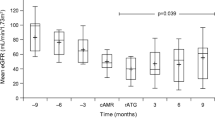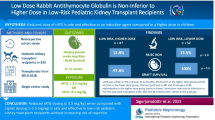Abstract
Purpose
To compare the long-term effects of the interleukin-2 receptor antagonist basiliximab versus rabbit antithymocyte globulin as an induction therapy for living-related renal transplantation.
Methods
This is a prospective, open-label, nonrandomized, controlled study including 213 cases of renal transplant. Immunosuppressive therapy containing calcineurin inhibitors, mycophenolate mofetil and steroids was applied in all cases. The interleukin-2 receptor antagonist group (IL2Ra group) included 108 cases with 20 mg basiliximab induction on Day 0 and Day 4. The other 105 cases comprised the rabbit antithymocyte globulin group (rATG group) with 1.0 mg/kg/day ATG induction from Day 0 to Day 4. The primary endpoint was biopsy-proven acute rejection. Other endpoints included delayed graft function (DGF), graft loss and death.
Results
All patients were followed up for 3 years. Acute rejection rates in the IL2Ra group and the ATG group were 5.6 and 3.8 % (P = 0.781), and the differences in the DGF rates, graft loss and death were insignificant between groups. All-cause infection rates in the IL2Ra and rATG groups were 26.9 and 43.8 % (P = 0.010). Urinary tract infections were more common in the rATG group than in the IL2Ra group (15.2 vs 6.5 %, P = 0.040). Specific viral infection rates were significantly different (18.1 % in rATG group vs 8.3 % in IL2Ra group, P = 0.035).
Conclusions
IL2Ra and rATG had no significant differences as induction therapies during the perioperative period of living-related renal transplantation, according to acute rejection rates, DGF rates, graft loss, 1- and 3-year patient/graft survival rates. However, the incidence of infection, especially of urinary tract infection and specific viral infection, was higher in rATG-induced patients.


Similar content being viewed by others
Change history
21 January 2019
In the original publication, incorrect grant number was included in the Acknowledgements text as ?This study (article) was supported by Natural Science Foundation Y16H050011 of Zhejiang Province, China?. The correct acknowledgement section is given here.
21 January 2019
In the original publication, incorrect grant number was included in the Acknowledgements text as ���This study (article) was supported by Natural Science Foundation Y16H050011 of Zhejiang Province, China���. The correct acknowledgement section is given here.
References
Brennan DC, Daller JA, Lake KD, Cibrik D, Del Castillo D (2006) Rabbit antithymocyte globulin versus basiliximab in renal transplantation. N Engl J Med 355(19):1967–1977
Bonnefoy-Berard N, Revillard JP (1996) Mechanisms of immunosuppression induced by antithymocyte globulins and OKT3. J Heart Lung Transpl 15(5):435–442
Michallet MC, Preville X, Flacher M, Fournel S, Genestier L, Revillard JP (2003) Functional antibodies to leukocyte adhesion molecules in antithymocyte globulins. Transplantation 75(5):657–662
Woodside KJ, Hu M, Meng T, Hunter GC, Sower LE, Daller JA (2003) Differential effects of interleukin-2 blockade on apoptosis in naive and activated human lymphocytes. Transplantation 75(10):1631–1635
Amlot PL, Rawlings E, Fernando ON et al (1995) Prolonged action of a chimeric interleukin-2 receptor (CD25) monoclonal antibody used in cadaveric renal transplantation. Transplantation 60(7):748–756
Bourdage JS, Hamlin DM (1995) Comparative polyclonal antithymocyte globulin and antilymphocyte/antilymphoblast globulin anti-CD antigen analysis by flow cytometry. Transplantation 59(8):1194–1200
Zand MS, Vo T, Huggins J et al (2005) Polyclonal rabbit antithymocyte globulin triggers B-cell and plasma cell apoptosis by multiple pathways. Transplantation 79(11):1507–1515
Liu Y, Zhou P, Han M, Xue CB, Hu XP, Li C (2010) Basiliximab or antithymocyte globulin for induction therapy in kidney transplantation: a meta-analysis. Transpl Proc 42(5):1667–1670
AI Najjar A, Etienne I, Le Pogamp P et al (2006) Long-term results of monoclonal anti-Il2-receptor antibody versus polyclonal antilymphocyte antibodies as induction therapy in renal transplantation. Transpl Proc 38(7):2298–2299
Patel HV, Kute VB, Vanikar AV et al (2014) Low-dose rabbit anti-thymoglobin globulin versus basiliximab for induction therapy in kidney transplantation. Saudi J Kidney Dis Transpl 25(4):819–822
Pilch NA, Taber DJ, Moussa O et al (2014) Prospective randomized controlled trial of rabbit antithymocyte globulin compared with IL-2 receptor antagonist induction therapy in kidney transplantation. Ann Surg 259(5):888–893
Brokhof MM, Sollinger HW, Hager DR et al (2014) Antithymocyte globulin is associated with a lower incidence of de novo donor-specific antibodies in moderately sensitized renal transplant recipients. Transplantation 97(6):612–617
Wang W, Yin H, Li XB et al (2012) A retrospective comparison of the efficacy and safety in kidney transplant recipients with basiliximab and anti-thymocyte globulin. Chin Med J (Engl) 125(6):1135–1140
Taber DJ, Weimert NA, Henderson F et al (2008) Long-term efficacy of induction therapy with anti-interleukin-2 receptor antibodies or thymoglobulin compared with no induction therapy in renal transplantation. Transpl Proc 40(10):3401–3407
Kim JM, Jang HR, Kwon CH et al (2012) Rabbit antithymocyte globulin compared with basiliximab in kidney transplantation: a single-center study. Transpl Proc 44(1):167–170
Buhaescu I, Segall L, Goldsmith D, Covic A (2005) New immunosuppressive therapies in renal transplantation: monoclonal antibodies. J Nephrol 18(5):529–536
Cai J, Terasaki PI (2010) Induction immunosuppression improves long-term graft and patient outcome in organ transplantation: an analysis of United Network for Organ Sharing registry data. Transplantation 90(12):1511–1515
Sandrini S (2005) Use of IL-2 receptor antagonists to reduce delayed graft function following renal transplantation: a review. Clin Transpl 19(6):705–710
Mourad G, Morelon E, Noel C, Glotz D, Lebranchu Y (2012) The role of thymoglobulin induction in kidney transplantation: an update. Clin Transpl 26(5):E450–464
Tullius SG, Pratschke J, Strobelt V et al (2003) ATG versus basiliximab induction therapy in renal allograft recipients receiving a dual immunosuppressive regimen: one-year results. Transpl Proc 35(6):2100–2101
Gabardi S, Martin ST, Roberts KL, Grafals M (2011) Induction immunosuppressive therapies in renal transplantation. Am J Health Syst Pharm 68(3):211–218
van den Hoogen MW, Hoitsma AJ, Hilbrands LB (2012) Anti-T-cell antibodies for the treatment of acute rejection after renal transplantation. Expert Opin Biol Ther 12(8):1031–1042
Mourad G, Rostaing L, Legendre C, Garrigue V, Thervet E, Durand D (2004) Sequential protocols using basiliximab versus antithymocyte globulins in renal-transplant patients receiving mycophenolate mofetil and steroids. Transplantation 78(4):584–590
Lebranchu Y, Bridoux F, Buchler M et al (2002) Immunoprophylaxis with basiliximab compared with antithymocyte globulin in renal transplant patients receiving MMF-containing triple therapy. Am J Transpl 2(1):48–56
Sollinger H, Kaplan B, Pescovitz MD et al (2001) Basiliximab versus antithymocyte globulin for prevention of acute renal allograft rejection. Transplantation 72(12):1915–1919
Kyllonen LE, Eklund BH, Pesonen EJ, Salmela KT (2007) Single bolus antithymocyte globulin versus basiliximab induction in kidney transplantation with cyclosporine triple immunosuppression: efficacy and safety. Transplantation 84(1):75–82
Acknowledgments
This study (article) was supported by Natural Science Foundation Y16H050011 of Zhejiang Province, China.
Author information
Authors and Affiliations
Corresponding author
Ethics declarations
Conflict of interest
No conflicts of interest to declare.
Human and animal rights
All procedures performed in studies involving human participants were in accordance with the ethical standards of the institutional and/or national research committee and with the 1964 Helsinki declaration and its later amendments or comparable ethical standards, and all organs originate from living-related donors.
Informed consent
Informed consent was obtained from all individual participants included in the study.
Additional information
Hong-Feng Huang and Jing-Yi Zhou have contributed equally to this work.
Rights and permissions
About this article
Cite this article
Huang, HF., Zhou, JY., Xie, WQ. et al. Basiliximab versus rabbit antithymocyte globulin as induction therapy for living-related renal transplantation: a single-center experience. Int Urol Nephrol 48, 1363–1370 (2016). https://doi.org/10.1007/s11255-016-1307-y
Received:
Accepted:
Published:
Issue Date:
DOI: https://doi.org/10.1007/s11255-016-1307-y




